Separation and culture method for primary hepatocytes of sheep
A primary hepatocyte, separation and culture technology, applied in the field of animal cell culture, can solve the problems of cell damage, low viability, easy to cause pollution, etc., and achieve the effect of stable proliferation and typical morphological characteristics
- Summary
- Abstract
- Description
- Claims
- Application Information
AI Technical Summary
Problems solved by technology
Method used
Image
Examples
Embodiment 1
[0066] (1) After soaking the lamb liver tissue in physiological saline containing 2wt% PS (the dosage ratio of the lamb liver tissue and physiological saline is 1g:5mL), wash with PBS buffer containing 1wt% PS for 3 Second, get lamb liver tissue a;
[0067] (2) Use sterile scissors to cut the lamb liver tissue a into 1mm 3 The tissue block was mixed with the complete medium by pipetting, and a cell sieve with a pore size of 100 μm was used to filter the larger tissue block and impurities, and the filtrate was collected to obtain a hepatocyte suspension;
[0068] (3) discard the supernatant after centrifuging the above-mentioned obtained hepatocyte suspension for 5 min under the condition of 800 rpm to obtain precipitation a;
[0069] (4) Mix the above-mentioned obtained precipitate a and the erythrocyte lysate according to the ratio of 1 g:3 mL, leave it to stand for 10 min at 25° C. and then centrifuge for 5 min under the condition of 800 rpm, discard the supernatant to obta...
Embodiment 2
[0073] (1) After soaking the lamb liver tissue in physiological saline containing 2wt% PS (the dosage ratio of the lamb liver tissue and physiological saline is 1g:5mL), wash with PBS buffer containing 1wt% PS for 3 Second, get lamb liver tissue a;
[0074] (2) Use sterile scissors to cut the lamb liver tissue a into 1mm 3 The tissue block was digested with 5 mL of collagenase IV at a concentration of 1 mg / mL in a water bath at 37°C for 15 min, with constant shaking during the period. After the digestion, complete medium was added to terminate the digestion, and a 100 μm cell sieve was used to filter the larger Tissue blocks and impurities, collect the filtrate to obtain hepatocyte suspension;
[0075] (3) discard the supernatant after centrifuging the above-mentioned obtained hepatocyte suspension for 5 min under the condition of 800 rpm to obtain precipitation a;
[0076] (4) Mix the above-mentioned obtained precipitate a and the erythrocyte lysate according to the ratio o...
Embodiment 3
[0080] (1) After soaking the lamb liver tissue in physiological saline containing 2wt% PS (the dosage ratio of the lamb liver tissue and physiological saline is 1g:5mL), wash with PBS buffer containing 1wt% PS for 3 Second, get lamb liver tissue a;
[0081] (2) Use sterile scissors to cut the lamb liver tissue a into 1mm 3 The tissue blocks were digested with 5 mL of collagenase IV at a concentration of 0.1 mg / mL in a water bath at 37 °C for 15 min, with constant shaking during the period. After the digestion, complete medium was added to terminate the digestion. Large tissue blocks and impurities, collect the filtrate to obtain hepatocyte suspension;
[0082] (3) discard the supernatant after centrifuging the above-mentioned obtained hepatocyte suspension for 5 min under the condition of 800 rpm to obtain precipitation a;
[0083] (4) Mix the above-mentioned obtained precipitate a and the erythrocyte lysate according to the ratio of 1 g:3 mL, leave it to stand for 10 min at...
PUM
| Property | Measurement | Unit |
|---|---|---|
| pore size | aaaaa | aaaaa |
Abstract
Description
Claims
Application Information
 Login to View More
Login to View More - R&D Engineer
- R&D Manager
- IP Professional
- Industry Leading Data Capabilities
- Powerful AI technology
- Patent DNA Extraction
Browse by: Latest US Patents, China's latest patents, Technical Efficacy Thesaurus, Application Domain, Technology Topic, Popular Technical Reports.
© 2024 PatSnap. All rights reserved.Legal|Privacy policy|Modern Slavery Act Transparency Statement|Sitemap|About US| Contact US: help@patsnap.com










